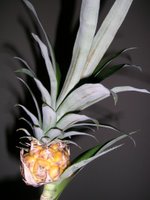Friday, December 01, 2006
Sunday, October 01, 2006
Wednesday, May 31, 2006
Red Pineapple
 An ornamental pineapple, in bloom, recently purchased from a Home Depot in California. The plant was labeled "Ananas comosus," with no variety information provided.
An ornamental pineapple, in bloom, recently purchased from a Home Depot in California. The plant was labeled "Ananas comosus," with no variety information provided. The plant is about ten inches tall and twelve inches wide. The leaves are completely spineless and dark red with green at the edges.
The purple blossoms are each about one-half inch long. The inflorescence (the cluster of flowers that will become the fruit) is about three-quarters of an inch in diameter and one inch tall (including the crown).
Based on the appearance of the fruit, it seems to have some similarity to Ananas comosus var. nanus, another ornamental dwarf pineapple. The nanus, however, has prominent leaf spines.
Thursday, March 16, 2006
Selecting a Fresh Pineapple
1. Firmness is probably the most important thing to look for. A pineapple with soft spots is almost certainly damaged or rotten.
2. Fragrance is usually a fairly good indicator of quality. If a pineapple smells good, it's probably delicious -- so long as it's firm and undamaged. (The opposite doesn't necessarily hold true -- a pineapple with no detectable fragrance at the store can also be good. )
3. & 4. It's generally a good idea to consider the crown and shell. However, these are more tie-breaker issues for deciding between two fruits. As pineapple scientists R.E. Paull and D.P. Bartholomew explain, pineapples -- unlike peaches or pears -- don't get any sweeter after they're picked. However, the shell of a pineapple will gradually turn yellow after it's been harvested (assuming it's a yellow-shelled variety). So, a fully yellow shell together with a leafy green crown may be a sign of a pineapple that is both fresh and that has been allowed to ripen fully. But, it's difficult to judge quality reliably based on these factors, especially for non-Cayenne pineapple varieties.
5. Season also matters. Thanks to "forcing" techniques that can be used to induce a pineapple plant to flower and produce fruit, pineapples are in-season year-round. However, Paull and Bartholomew point out that fruits that mature during cooler months with less sunlight tend to have a lower sugar and higher acid content. What the cooler months are all depends on where the pineapple is grown.
6. Finally, don't forget that there are different pineapple varieties. The most common varieties available in the western United States are the Smooth Cayenne and the Gold. The Cayenne is the pineapple most people are probably familiar with: spineless, yellow-shelled, cylindrical. The Gold is a low-acid Cayenne hybrid that was developed at the now-defunct Pineapple Research Institute. Also, later this year, Del Monte Fresh Produce is expected to launch a new pineapple variety, the Honey Gold, based on a variety developed in Taiwan.
Postscript
The New York Times has a 1982 guide to choosing a fresh pineapple by Mimi Sheraton in its archive. Some of the information contained in the guide may be somewhat out of date, but it's probably the most detailed treatment on the subject of fresh pineapple selection freely available on the web.
Sunday, February 26, 2006
Ludicus Pineapple
 A "lucidus" pineapple plant (Ananas comosus var. lucidus [?]). The plant was in fruit when purchased -- probably by chemical forcing, given the small size of the plant. Complete ripening took about six months from time of purchase.
A "lucidus" pineapple plant (Ananas comosus var. lucidus [?]). The plant was in fruit when purchased -- probably by chemical forcing, given the small size of the plant. Complete ripening took about six months from time of purchase.
Close-up of the lucidus fruit after harvest. Similar lucidus pineapple plants are currently being sold at Home Depot stores in California.
 Cross-section of the lucidus fruit with crown removed. The fruit (about the size of a hen's egg) may have been slightly overripe. It was fairly sweet with a pronounced acidity, perhaps the result of winter-time ripening.
Cross-section of the lucidus fruit with crown removed. The fruit (about the size of a hen's egg) may have been slightly overripe. It was fairly sweet with a pronounced acidity, perhaps the result of winter-time ripening.
